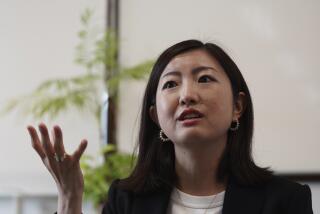The Long Arm of the State
- Share via
TOKYO — Why do the Japanese not eagerly embrace the ideals of free markets, deregulation and consumer sovereignty? Their reluctance perplexes U.S. policy-makers and corporations eager to open the Japanese economy.
It is well known that Japan’s business community has welcomed the guiding hand of the government in industrial policy. Yet, few Americans realize the extent to which the Japanese state has promoted economic development by actively managing and mobilizing society itself. To most Japanese officials and businessmen, the country’s ability to compete in the next century rests as much on maintaining safe streets, intact families, the work ethic, low welfare spending and high rates of saving. These favorable conditions are not expected to endure by themselves, but to depend on the government’s continuing efforts to mold the behavior of its people.
Only by recognizing the widespread commitment to “social management” can we make sense of the current Japanese debate over deregulation. Take the “Blue Bird Plan” put forward by the leading employers’ federation, Nikkeiren. Echoing American free-market thinkers, the proposal boldly seeks to eliminate government regulations that raise production costs and erode Japan’s international competitiveness. Yet, in attacking the nation’s legendary high prices, the business federation calls not for freer markets or an end to the inefficient distribution system, but for a massive government campaign to “educate” consumers to spend less money on goods. Consumers themselves, the manifesto complains, have brought about the country’s high price levels, paying top yen for brand names regardless of quality. Aptly enough, the Blue Bird Plan recommends against following either the U.S. or European economic models. Japanese must find, in the words of the song, their own “blue bird” of happiness.
In no other democracy has the government mobilized its populace behind strategic economic policies as successfully. Campaigns to promote household saving are a prime example. The Japanese on average save 13% of disposable income, compared with only 4% in the case of Americans. With great fanfare, 11 years ago, the government announced plans to stimulate consumption on a massive scale. In reality, Japan remains the only advanced economy with an official agency devoted to encouraging saving. Established in 1952, the Central Council for Savings Information works with local schools and civic groups to inculcate habits of thrift. Housewives’ magazines lend a helping hand, with story after story about clever homemakers who cut wasteful expenditures and record all spending and income in account books.
Moreover, the government has successfully dampened public expectations of more generous welfare programs for the elderly. Though social spending has steadily risen as the population ages, Japan has thus far avoided many of the costs that Western nations pay to institutionalize the frail or support the independent living of healthy seniors. Some 55% of Japanese aged 65 and older were living with their children in 1994. At a time when comparable figures have dropped below 20% in Western societies, the slow decline of the Japanese family as the primary welfare institution owes much to managerial efforts by the government. In a deft public-relations campaign spanning the last two decades, officials and a cooperative media have persuaded the public that Japan faces an “aging-society crisis.” Only if families, particularly wives, continue to care for the elderly, the message goes, will Japan escape the rising costs of entitlements experienced by its economic rivals.
Indeed, women play central roles in the government’s social management. Americans are quick to deny the existence of a Japanese “women’s movement,” having found few U.S.-style feminist organizations. Yet, millions of Japanese women belong to local women’s associations. While these groups sometimes take issue with national policies, for the most part they provide the ground troops for the many official campaigns. They promote household saving, discourage use of credit cards and assist the police in crime prevention. In addition, women constitute the vast majority of the 5 million “volunteers” whom the central bureaucracy has aggressively recruited to serve as unpaid social workers and thereby contain welfare costs.
Japan’s preoccupation with managing society has had a long history, and is not likely to disappear soon. During the first half of the 20th century, few areas of what Americans regard as “private” escaped supervision by the state. Officials mounted an endless stream of nationwide “moral suasion” campaigns. The people were exhorted to save more money, buy fewer imports and work harder to avoid relying on public assistance. At the local level, tens of thousands reinforced government policies within the many state-sponsored trade associations and neighborhood groups.
Even the flourishing brothels became instruments for strengthening the nation. As state regulators explained, licensed prostitution served to satisfy the urges of husbands and thus preserved family units. Prostitutes also enabled single men to forego marriage, and thus to avoid the costs of supporting families and so reduce aggregate national consumption. Although Japan became a more democratic polity after World War II, many of the cozy relationships between the state and civic associations persist to this day.
In an age when Americans lament the decline of volunteerism and social capital, there is something appealing about the Japanese government and local activists working together to improve communities or teach methods of sound personal finance. On the other hand, intimate relations between the state and civic groups inhibit the rise of more independent movements that might challenge the government’s anti-consumer orientation and its miserly welfare programs.
What we witness all too often are not “a thousand points of light,” but a concentrated beam emanating from Tokyo. For better or worse, these patterns of social management remain a fundamental fixture of the Japanese political economy. By understanding them, we may deal more realistically with a nation that shows few signs of adopting American norms and policies.
More to Read
Inside the business of entertainment
The Wide Shot brings you news, analysis and insights on everything from streaming wars to production — and what it all means for the future.
You may occasionally receive promotional content from the Los Angeles Times.










